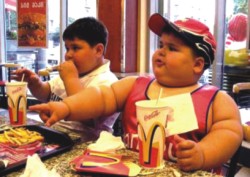|
View from the Bottom
“Feast - A festival. A religious celebration usually signalized by gluttony and drunkenness, frequently in honour of some holy person distinguished for abstemiousness. In the Roman Catholic Church feasts are "movable" and "immovable," but the celebrants are uniformly immovable until they are full. In their earliest development these entertainments took the form of feasts for the dead; such were held by the Greeks, under the name _Nemeseia_, by the Aztecs and Peruvians, as in modern times they are popular with the Chinese; though it is believed that the ancient dead, like the modern, were light eaters. Among the many feasts of the Romans was the Novemdiale_, which was held, according to Livy, whenever stones fell from heaven.”
Live to Eat or
Eat to Live?
Shahnoor Wahid
 Here is an interesting story. Meeting Mohammed Ali Jinnah in Dhaka, Sher-e-Bangla Fazlul Haque said, “Looking at you people of the world will think there is a famine in Pakistan.” Jinnah immediately pointed at Fazlul Haque's huge structure and stomach and said, “And looking at you they will know the cause of it.” Even if it is a concocted story, it does evoke laughter. And if it is true then one must marvel at the sense of humour of our past politicians (they did not attack one another with guns and grenades). Here is an interesting story. Meeting Mohammed Ali Jinnah in Dhaka, Sher-e-Bangla Fazlul Haque said, “Looking at you people of the world will think there is a famine in Pakistan.” Jinnah immediately pointed at Fazlul Haque's huge structure and stomach and said, “And looking at you they will know the cause of it.” Even if it is a concocted story, it does evoke laughter. And if it is true then one must marvel at the sense of humour of our past politicians (they did not attack one another with guns and grenades).
There is another story about Sher-e-Bangla, and though we cannot guarantee its authenticity, we nevertheless enjoy it immensely. Sher-e-Bangla was going somewhere in Barisal by a country boat. During lunch time the two boatmen bought four large size hilsha fish (good enough for 16 people). Fazlul Haque looked at the fish and said, “Good, but what are you people going to eat?”
Well, today's story is about food and nutrition and the lack of it . In fact it is about nutritional divide. On one side people have more than what they need to have a healthy life and on the other people have less than what they need to survive. Overeating of nutritious food, Junk food, soft drinks, avoiding vegetables and bodily activities are making people in the West overweight, which is considered by health experts a veritable health concern. People, literally, are dying of eating or to put it differently - they are eating away their precious life. They live to eat, not eat to live. Overactive taste buds, high nutrition content in food, better disease control and sedentary lifestyles are to be blamed in general for the growth of obesity in the West, and to some extent in Japan. The weighty populace and their health problems (diabetes, heart) have caused a stir in the US and UK and the governments of the two countries have decided to do something about it.
 In the US, administration has decided to include cooking in the school curricula so that students from very young age can have clear knowledge about food and nutrition. They want them to have a better idea about health food so that they can cook their own food at home. Great. This gives us an idea, a bright one indeed. Why not send our cooking experts on the TV shows to the US to teach students there how to cook healthy food? That would mean we would add another export item in our list cooking and thus earn some foreign currency. Please let us have your opinion. In the US, administration has decided to include cooking in the school curricula so that students from very young age can have clear knowledge about food and nutrition. They want them to have a better idea about health food so that they can cook their own food at home. Great. This gives us an idea, a bright one indeed. Why not send our cooking experts on the TV shows to the US to teach students there how to cook healthy food? That would mean we would add another export item in our list cooking and thus earn some foreign currency. Please let us have your opinion.
In the UK a study shows that if obesity is not controlled, especially among children, then 60 per cent of the Britons will be obese with health problems in another 25 years. Good Lord! Imagine London buses looking wider with wider seats to accommodate overweight passengers! Even restaurants and opera houses will have to have wider chairs and tables to entertain rich but overweight customers!
Contrary to the above two news items fro the West, a recent news item says that we have nutrition problems affecting the majority of the population. Two thirds of the children suffer from severe malnutrition that often causes their death or deformity. Food intake among the majority of the people is minimal and whatever they eat contains very little nutritional value. So, you see, this is what we call the 'nutritional divide.'
Copyright (R) thedailystar.net 2008
|
